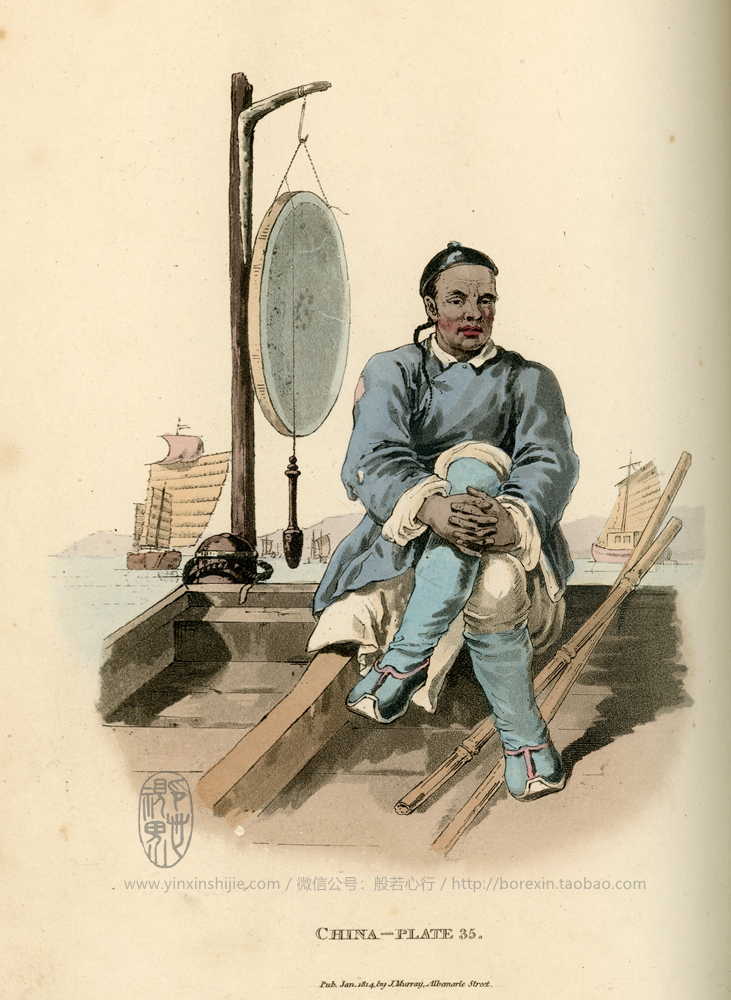【老书】 坐在船里的船夫-《中国人的服饰和习俗图鉴》(1814年出版)

▲坐在船里的船夫-《中国人的服饰和习俗图鉴》(1814年)
英文备注译文:
有数百万中国人完全生活在水上,生活在各种各样的船只和驳船上,一些人忙于运送食品和商品,另一些人负责运送乘客,一些人负责饲养鸭子,另一些人从事渔业。其中一些船只有桅杆和帆,其他船只用大型双桨推进或用杆子推动,一些船只由人拖拽,另一些船只则很少由马拖拽。
在每艘船只的船头附近,在某个方便的地方悬挂着一种在我国很有名的叫作“龚”的嘈杂仪器,用于调节跟踪器的运动,并向其他船只发出信号,告知发出信号的船只的接近和意图。当一只大鹰即将下锚或在夜间停飞时,来自四面八方的锣声响起;中国人从每一种语言的独特模式中清楚地理解了每一种语言的含义。
英文原文:
Some millions of Chinese live entirely on the water , in boats and barges of various kinds , some occupied in carrying articles of provision and merchandise , others in conveying passengers , some in feeding and rearing ducks ,and others in fishing . Some of these vessels have masts and sails , others are forced forward with large sculls or pushed on with poles , some are dragged along by men ,and others , but very rarely , by horses.
near the head of each vessel is suspended , in some convenient place, one of those noisy instruments well known in this country by the name of gong , which is used to regulate the motions of the trackers , and to give notice to other vessels of the approach and intentions of the one that beats the signal . Where a large fleeet is about to come to anchor or make fast for the night , there is a tremendous crash of gongs from all quarters ; the meaning of each of which is distinctly understood by the Chinese , from the peculiar mode in which each is struck.
威廉·亚历山大(William Alexander,1767~1816)英国画家。
生于英国肯特郡,父亲是英国坎特美斯顿城马车画匠。
自小受到父亲的熏陶,对绘画产生浓厚兴趣。
15岁时随父亲到伦敦,他于1784年入皇家学院学画,一直学到1792年。易卜逊对其才能倍加赞赏,把他推荐给马戛尔尼勋爵。
他在伦敦皇家艺术学会展览并出版画册和书刊,出版彩色的《中国服饰》及《中国衣冠举止图解》(Picturesque Representations of the Dress and Manners of the Chinese 1814)两书,介绍中国风光,使英国和欧洲人民对中国有了形象的认识,促进西方对中国的了解。
在澳门期间,他画了一幅题为《从外海眺望澳门景色》的水彩画,描绘了18世纪澳门城市风貌。同时也显示了英国对于澳门的觊觎,成为澳门历史和中英关系的重要佐证。
1808年,转任大英博物馆的印刷画及素描画管理员,直至去世。
长按下面识别二维码
如有疑问或想了解更多,请加微信:



 关注官方微信
关注官方微信
